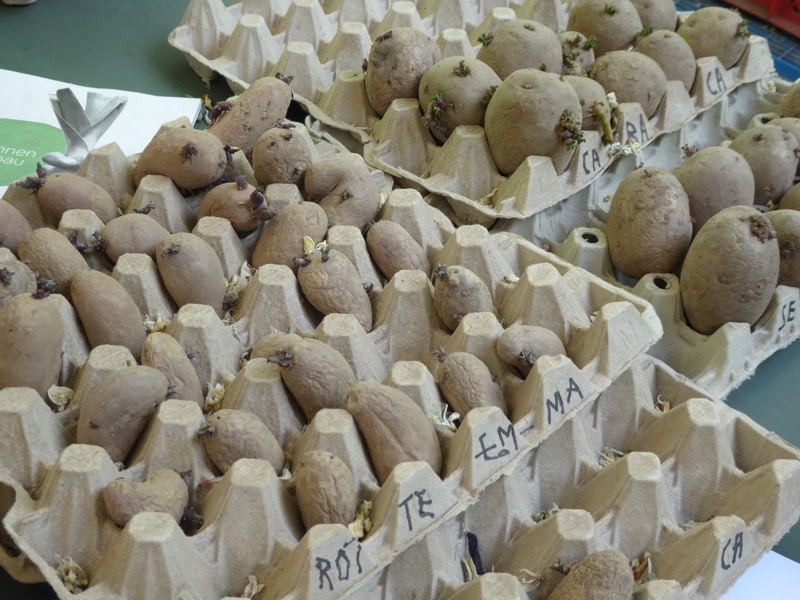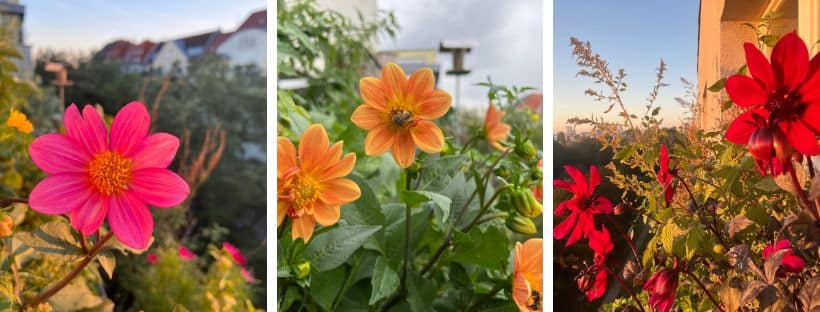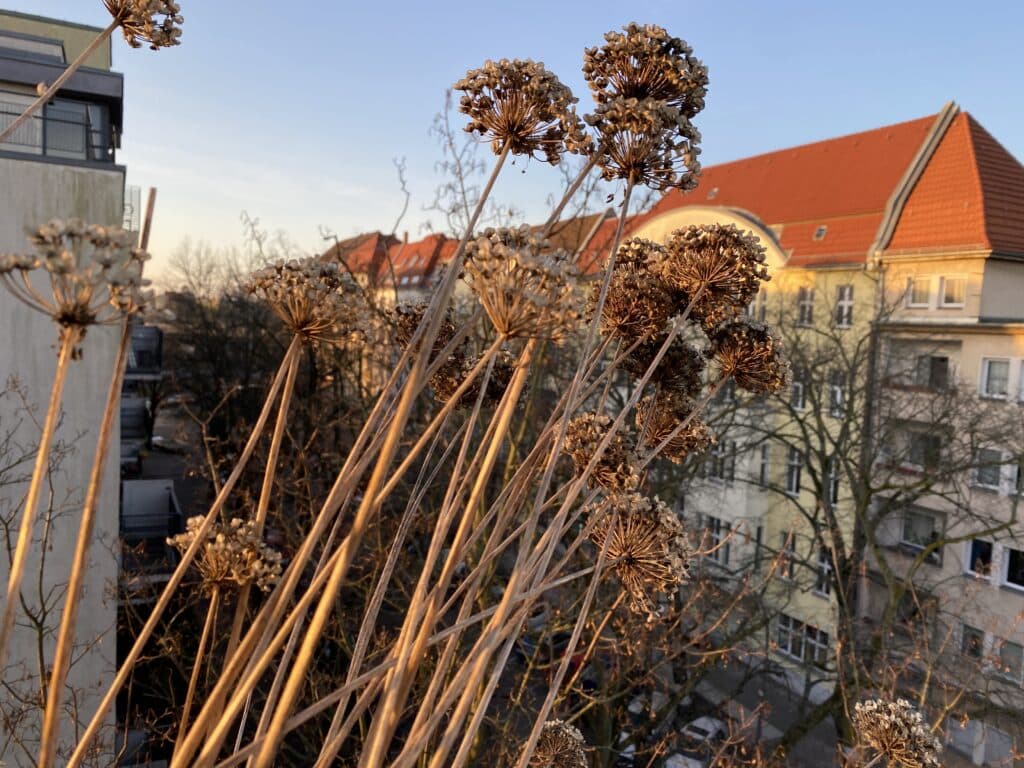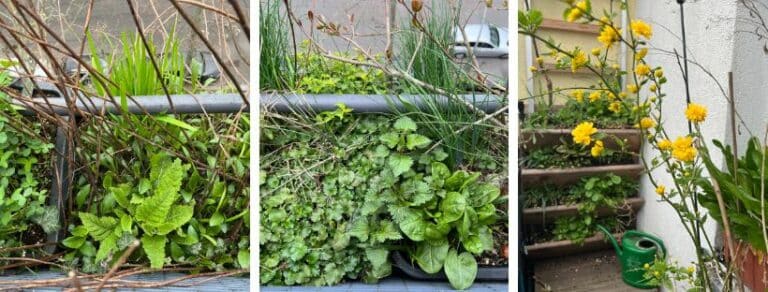It’s so much fun to watch the plants grow, because they are putting on weight. The weather may be April-like, but our plants are clearly growing. The desire for a nice cozy balcony where you can relax is growing. But take your time with pruning the plants and tidying up. The insects still need their wintering quarters. Read the following article to find out what can be sown and planted for the balcony in April and what tasks need to be done.
Seeds can be sown in April:
The links lead to recommended organic varieties suitable for the balcony. Pre-cultivation means growing indoors on the windowsill. All other crops can be sown outside in the final pot.
- early lettuce May King
- Asian salads, Asian salad mix as a simple seed disc
- Batavia lettuce “American brown” (particularly suitable for baby leaf cultivation)
- Tomatoes (preculture). Recommended varieties for the balcony: pole tomato (Green Zebra) Cocktail tomato (Ruthje, Siberian pear, Fredi, Yello Submarine, Vesennij Mieurinskij), bush tomato/balcony tomato (Little Red Riding Hood, Pauline, Balcony starling), hanging tomato (Tumbling Tom Red), wild tomato (Golden Currant, Red marble)
- Basil (preculture)
- Savory
- Dill
- Parsley
- Zucchini (preculture), recommendation balcony: Cocozelle of Tripoli, Zuboda, round Tondo chiaro di Nizza
- Pumpkin (preculture), suitable for balconies: Sweet Dumpling, Table Queen, Zaphito, Hokkaido, Patisson
- Swiss chard (preculture), recommendation red-stemmed Feurio, white stemmed Smooth silver, yellow Oriole, mixture of four colors Rainbow and Bright Lightsgreen chard for baby leaf cultivation: Verde da Taglio
- Beet
- Radishrecommendations for the tub: Sora, Rudi, Icicle, French Breakfast2
- Cucumber (pre-cultivation), Vesper cucumber for balcony: Persia, Mini cucumber La Diva, Country cucumber Tanjastrongly climbing, climbing varieties: Mexican mini cucumber, Inca cucumber (squash)
- PeaRecommendation Sweet pea Ambrosiapigeon pea Miracle of Kelvedonpurple-flowering sweet pea with blue pods Blauwschokker
- Kohlrabiblue recommendation: Blaro, Azur Starwhite: Orinoco
- SpinachRecommendation Verdil, Thorin, Butterfly
- Malabar spinach (preculture), New Zealand spinach (preculture), Baumspinat ‚Magenta Spreen‘ (preculture)
- Cultivation of Microgreens and sprouts on the kitchen table and windowsill
- Plant Jerusalem artichokes — simply take a tuber from the organic market in a bucket-sized bucket or larger
On the (deviating) sowing dates
Just as the information on the seed packets and seed suppliers’ websites varies, so do the sowing calendars of seed suppliers and gardeners’ websites. Regional conditions are different everywhere and experiences vary. Our balconies in the cities have even more different conditions due to the heat of the city and radiating house walls. Here too, it is important to COURAGEOUSLY, PLAYFULLY and EXPERIMENTALLY gather your own experience and SEED. The seed itself ultimately decides after sowing whether the conditions of light, water and temperature appear favorable for germination or not until later.
Good information on sowing dates and conditions at:
-
- Bingenheim seeds, special page Current seeds for April — what can I sow now?
-
- Janet Glausch Natural garden seeds from Leipzig Special page — What can I sow now in April?
Do I have to buy new soil at the start of the season?
No, it doesn’t have to be thrown away. Here you can read about the possibilities of spicing up used soil: 5 ways to get strength into old balcony box soil without buying new soil every year.
Potatoes
Potatoes can be pre-germinated for sowing. In warmer regions, they can be planted outside if the tender shoots are protected from frost with a cloche or fleece.
Instructions 🥔 see comment.

Please also plant native wild plants
The popular annual summer flowers nasturtiums, zinnias and marigolds can now be grown indoors as they do not yet tolerate the cold. Sunflowers, cosmos and marigolds can already be sown outside. Robust native wild plants, which are more beneficial to our native insects, are also sown outside. In the project Thousands of gardens Thousands of species is a wealth of information on native wild plants to promote biodiversity for planting animals — and regional nurseries where they are sold. The flowers of our native wild plants are beautiful and encourage pollinating insects and also “beneficial insects” in the “pest” defense. A good tool for finding plants with ecological aspects is the ingenious plant database NaturaDB.
Great wild plants with beautiful, insect-friendly flowers can be sown on the balcony in February (until June):
I have marked my favorite proven wild plants for containers in bold. Location, flowering period, flowering color, size/height/spacing, perennial/biennial or annual, information on sowing, germination period, use/edibility and which animals use them (1TP5 animal plants) can be found in the link.
Yellow flowers:
Blue and purple flowers:
Pink and red flowers:
White flowers:
Bulbs (here together with delicious common yarrow)
The faded bulbs of daffodils, tulips, dwarf irises, … can be cut away, but not the foliage. The foliage needs to be left alone to brown, the bulbs need the strength for the next year.

Planting and caring for fruit trees and shrubs
Last chance to plant fruit trees, as the usual planting period for bare-rooted trees ends in April, although trees in containers can be planted all year round. Columnar apples work very well. Wild fruit such as chokeberries, cornelian cherries and rock pears make us very happy. Of course, soft fruit such as raspberries, blackberries, currants and gooseberries. Strawberries planted now as an underplanting will not bear abundantly in the first year, but will do so the following year. Monthly strawberries or continuously bearing strawberries are great (Mara des Bois). The existing soft fruit with Worm humus or compost or mulch with horn shavings or Sheep’s wool pellets fertilize as a slow-release fertilizer.
Herb balcony
Perennial herbs such as mint, lemon balm, chives or lovage can still be divided in April. To do this, cut the root balls into several pieces and replant them individually.
Order organic dahlias

The dahlia tubers are brought out of hibernation. Place them in pots with a good substrate and forge ahead at around 15 degrees. They can be placed outside from mid-May. Only Dahlias with unfilled flowers benefit the insects (use the discount code biobalkon25).
Harvest in April
Wenn die Tage nun wärmer und länger werden, wirst Du merken, dass die Pflanzen beginnen, einen Wachstumsschub zu machen. Gegen Ende des Monats kann gepflückt werden: Neben Blattgemüse wie Mangold, Grünkohl, Löffelkraut, Winterkresse, Schnittknoblauch, Schnittsellerie und Asia-Salaten können auch die frostharten Küchenkräuter Rosmarin und Salbei geerntet werden. Wer Topinambur gesetzt hat, die können jetzt ausgegraben werden, eine Knolle im Topf belassen für die nächste Saison. Von unseren heimischen Wildpflanzen Sauerampfer, Beifuss, Vogelmiere, Löwenzahn, Giersch und Brennnesseln können junge Triebspitzen geerntet werden.
Want to know more about growing the three most important edible wild plants? Their vital substance density is so much better than that of common salads. They are also Dandelion, goutweed and nettles They grow vigorously, they sprout again and again, we can harvest young shoot tips again and again.

Keep your feet still, don’t cut anything down

Wie im ganzen Herbst und Winter gilt: Abgestorbene Stängel stehen lassen, weil es wichtige Quartiere für Insekten sind. Also nach wie vor die Füße stillhalten und sich auf die Saison freuen! Früher säuberten die Menschen zu dieser Zeit auch alle ihre Töpfe. Aber das ist nicht nötig, das diente wohl vor allem dazu, Gärtner im Winter zu beschäftigen.
Winter protection — tidying up?
To protect our insects, wait with the tidying up, with the pruning, delay it, they still need their winter quarters. Please leave it “untidy”, even if the sun is shining beautifully and the early bloomers are already peeking out and starting to blossom. It is often still too early to cut them back. The fresh green of the perennials can be clearly seen. Store the cut stems and foliage as loosely and airily as possible in a SUNNY PLACE for about 5 days so that the insects can crawl out. Here, biologist Elke Schwarzer talks about overwintering guests and when to prune.
Sources of supply
Our Green card with non-toxic organic (producing) nurseries and organic balconies
Discounts and recommendations for the organic balcony movement









20 Responses
Thanks for the great plant tips 🙂
This is a great list of what can be sown now and all the plant profiles.
With pleasure, dear Uli. I only took up the wild plant profiles this year when I got to know and appreciate Janet Glausch from Naturgarten-Samen in Leipzig. We have agreed on a contribution on plant propagation for the next but one Organic Balcony Congress. Kind regards Birgit
oh…that sounds great…i love the biobalkon congress 🥰 if only i had more balkons…🙈🥳 lg nico
Thanks — great tips and links!
What is the best way to plant potatoes and what size tub do I need? Bag or similar for how many potatoes?
Thank you and best regards
Stephanie
Dear Stephanie,
Potatoes are very sensitive to frost, but even at relatively low soil temperatures, around 8° C, the tubers sprout. The warmer the soil is, the quicker this happens, so urban balcony dwellers have an advantage once again. Pre-sprouting accelerates the development of the plant and is highly recommended, as the plant gains a head start in the race against any diseases. To do this, the tubers are placed in a bright place at a temperature of at least 10 °C to 15 °C (no direct sunlight!); placing them in egg cartons works well. As soon as the seedlings are one centimeter long, they are planted.
You will need a large, high plastic bucket with holes in the bottom, or a simple plastic sack (e.g. an empty sack from the soil store, but make sure you cut holes in the bottom so that the water can run out) or a jute sack, e.g. from a coffee roasting plant. Fill the bucket or sack with a layer of fine gravel or expanded clay or pumice about ten centimetres high as a drainage layer. Then add 15 centimetres of peat-free organic vegetable soil or peat-free plant or universal soil. Depending on the size of the container, place three to four pre-sprouted seed potatoes on top and keep them evenly moist. As soon as the green shoots are ten centimetres long, add enough soil (“pile on”) so that only the tips of the shoots are still visible. Repeat this until the pot is filled to the top with soil. Between June and August, the flowers will appear in white to purple with yellow anthers. This produces several layers of new potato tubers, which are ready to harvest around 100 days after planting. Make sure that the soil does not dry out and cover the planting container with a plastic fleece on frosty nights to prevent the foliage from freezing. As soon as the potato foliage shrinks and the plant turns brown, the tubers can be collected.
We have always celebrated potato festivals with my son, the annual potato harvest was a celebration that we will both never forget. You can’t expect a huge yield from a tub/bag, but we get to know the potato plant and how it behaves. The home-grown potatoes taste delicious and the special varieties with purple or pink skins and purple insides are a discovery and a feast for the eyes. I should probably write a blog post about them :).
Have fun!
Kind regards
Birgit
Thank you very much — my grandchildren really want to grow potatoes!
You should definitely do this — write a blog post about potatoes in raised beds 😉
Thank you for your wonderful work for us and for Mother Earth and your big heart in sharing 🤗
Thank you dear Meggi 💚💚💚💚💚💚💚
Very interesting and inspiring topic.
Wonderful dear Alicja. I am happy about every fellow campaigner who gets inspired and plants their balconies, windowsills and other possibilities. It’s always good for the climate in our cities and personally enriching to look after plants. Kind regards Birgit
Dear Birgit, I admire your balcony and the topics are very interesting. My balcony has full sun from about 2 pm until the evening.
What can I plant that is edible? I am interested in wild plants. What kind of soil can I use?
Thank you very much, Marlene
Dear Birgit,
Thank you so much for your planting and sowing recommendations! You already have so much blooming and greenery on your balcony that you can eat, it’s just wonderful and I really like the tiered planting at the edge with the support boards at the front. Is there a flower box behind each one and are there any instructions? I’m assuming that it’s homemade.
Sunny greetings,
Marita🌷🌼🥀
I’m new and don’t understand a lot of things yet. Do I still have to edit my profile? What great information from you Birgit. But my question now: what can I grow on my north/east balcony? Thank you very much for all you do.
Greetings from rainy Weinsberg
Dear Doris, at the 14th Online Organic Balcony Congress we focused on shady balconies and balcony situations. Unfortunately, you didn’t look at the contributions on this topic. All plants with dark green leaves are particularly suitable. The dark green color is due to the high chlorophyll content, the little light can be metabolized well. Kale, palm kale, spinach, the Asian lettuces ‘Mizuna’, ‘Green in Snow’, ‘Red Giant’ as well as wild rocket and lettuce are well suited. Funkias are also edible. Woodland plants (low light!) such as woodruff, wild garlic, deadnettle. Basil also does well. I’m always in favor of trying out lots of things. The test shows whether the plants can cope. You don’t need to edit a profile. The question may have flopped because the default setting is for you to receive my answer directly in your mailbox. Kind regards Birgit
Dear Birgit, thank you very much for your help. I watched all the contributions to the 14th Congress, I even bought it. But I can’t remember that much information, my head is full of serious private problems at the moment. And so far I haven’t been able to find access to the congress I bought, it says it’s not activated. I’m sorry, I’m not at my best at the moment.
Greetings Doris
Dear Doris, I understand that. My mom passed away on Sunday. These difficult times come again and again. Personally, gardening, the green view, the animal visitors, the enjoyment of my leaves help me a lot to get and stay centered. Things don’t run smoothly for me either, but I’m always moving forward. I have just sent you the access data for the congress package again so that you can have a look when you feel like it. You will have permanent access, so the viewing can wait. If the plants listed above help you first and you then look at what has particularly dark green leaves, you are on the safe side. Everything takes time and will sort itself out. Kind regards Birgit
Dear Birgit, oh I’m sorry, my heartfelt condolences.
Many thanks for the renewed access. Now it has worked. I’m muddling through now. Take another look and start again on my balcony. The unicorn is slowly feeding. It will.
All the best and sleep well
Doris
I am interested
Dear Brigitte, many thanks Dank♥️